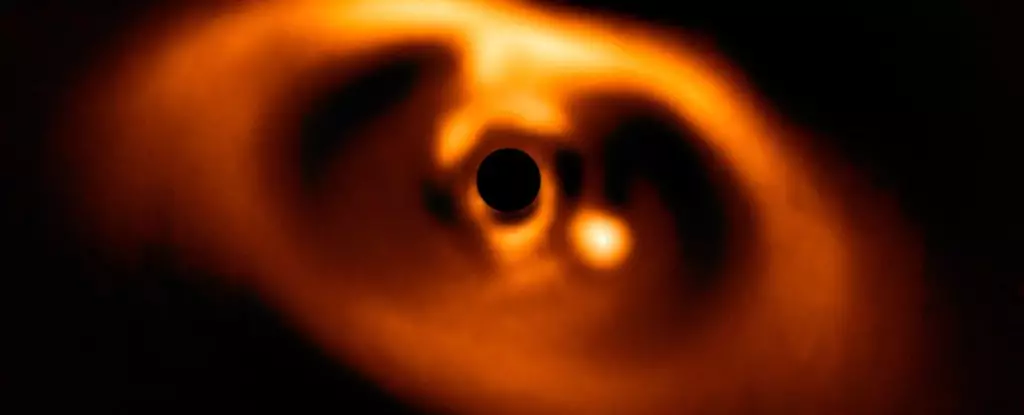The realm of modern astronomy is witnessing a significant transformation, characterized by groundbreaking discoveries that challenge traditional beliefs. One of the most pivotal areas of examination has been the formation of planetary systems. Historically anchored in the Nebular Hypothesis—an explanation implying that stars and their associated planets emerge from dense cosmic clouds—a recent study has introduced a compelling anomaly that alters our understanding of this process. With advanced telescopes, sophisticated instruments, and the power of machine learning at our disposal, astronomers are diving deep into phenomena once thought to be well understood, revealing complexities that suggest the story of planet formation is far from straightforward.
Leading this charge of inquiry is a recent investigation into an exoplanet known as PDS 70b, nestled in a dynamic star system about 366 light-years away from Earth. This young planet orbits a variable star, and what makes it particularly noteworthy is its location—within the cavity of a protoplanetary disk, a remnant of the gas and dust that birthed it. The study, guided by Postdoctoral Associate Chih-Chun “Dino” Hsu from Northwestern University’s Center for Interdisciplinary Exploration and Research in Astrophysics (CIERA), has uncovered significant discrepancies in the carbon-to-oxygen ratio of the planet’s atmosphere compared to that of its natal disk.
The implications of this finding are profound, as they throw into question the established correlation between the atmospheric composition of forming planets and their surrounding protoplanetary material. The research team involved the collaborative efforts of leading institutions, including Caltech and the University of California campuses, extending the impact and reach of their observations.
To obtain these pivotal measurements, the astronomers employed the Keck Planet Imager and Characterizer (KPIC), an innovative tool at the W.M. Keck Observatory. The KPIC’s advanced capabilities allowed them to secure spectroscopic data from the faint planet even as their readings were overshadowed by the brightness of the surrounding star. Jason Wang, an assistant professor involved in the project, emphasized the challenges faced and how this cutting-edge technology provided a solution. The ability to discern the faint light of PDS 70b against a luminous backdrop marked a milestone in observational capability, enabling scientists to analyze the atmospheric characteristics of celestial bodies that had previously eluded direct examination.
What the team discovered was unexpected: the carbon-to-oxygen ratio of PDS 70b’s atmosphere was markedly lower than that found in the protoplanetary disk. Initially, it was anticipated that the ratios would align if the planet had primarily accumulated material through gaseous accretion. This finding suggests a more nuanced narrative regarding how planets form. The researchers proposed two potential scenarios to address the discrepancies: either PDS 70b formed prior to the_disk being enriched with carbon, or it primarily grew by assimilating solid materials, alongside gases, altering its elemental composition in the process.
This revelation initiates a reevaluation of long-held theories about planetary development, hinting that the dynamic interplay between gaseous and solid accretion could significantly influence the characteristics of forming planets. As Hsu aptly noted, this research debunks the overly simplistic view of planetary chemistry, while Wang elaborated on how accumulated ice and dust—evaporating before being integrated into the planet—may influence carbon and oxygen ratios, marking a fundamental shift in our cosmological understanding.
The groundbreaking nature of this research opens doors toward further investigation, with the team setting sights on another fledgling exoplanet within the same system, known as PDS 70c. By analyzing this additional planet’s atmospheric composition in conjunction with that of PDS 70b, researchers aim to create a more comprehensive narrative concerning the formation history of this fascinating system.
The current findings emphasize the complexity and variability inherent in planet formation, sparking curiosity and laying the groundwork for future studies exploring diverse planetary systems. As our observational techniques develop, we can anticipate more revelations, each possessing the potential to reshape our understanding of the cosmos.
The inquiry into PDS 70b signifies a major milestone in astrophysics, showcasing how emerging technologies and methods can unveil the intricacies of planetary formation, illustrating that our cosmic journey is filled with more questions than answers. As scientists continue to unravel these mysteries, the age of shifting paradigms in astronomy is only just beginning.


Leave a Reply